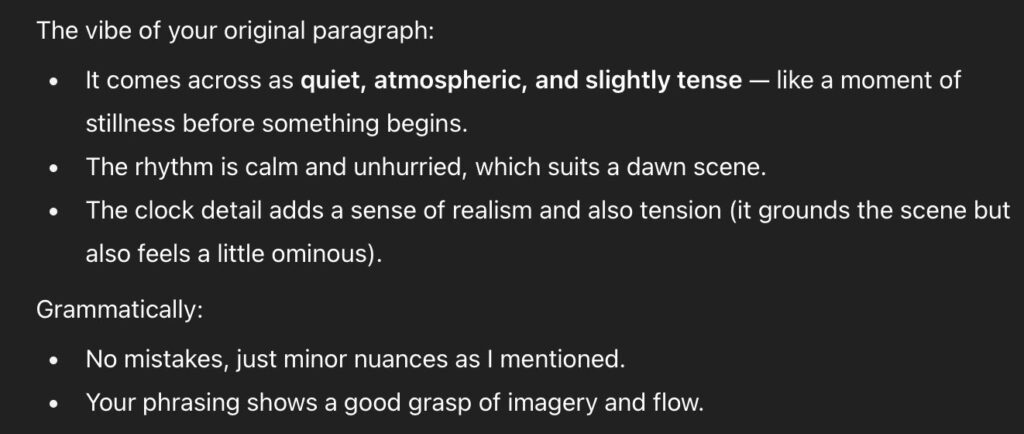
The other day, I was imagining a whacky scenario in which my submission was rejected. Then I was accused of using AI in my writing, and I was trying to defend myself.
I like to go on such trips inside my head…
Do what you want with this information. I just think that this is an interesting topic for discussion.
You may have seen the writing community adamantly reject AI and anything related to it. It’s just like they say:
No one wants to read a book if the author couldn’t even be bothered to write it in the first place.
And I fully and wholeheartedly agree with this notion.
In fact, I was the only anti-AI writer on the marketing team back in my corporate days. I even made an entire presentation on Writing with AI. I prepared it in just two days. The whole experience was like a fever dream. Still, I had the time of my life explaining, with memes and pop-culture references, that no AI is as precious, original, and imaginative as your own mind.
Still, the corporate world keeps spinning, and AI has already become an integral part of it. And if you want to be employable in that market, you need to have at least an idea of how to use AI to increase your productivity and output.
How I use AI for “writing”
Ever since the ominous launch of ChatGPT, I’ve been fooling around with the AI chat, throwing ideas at it and marvelling at the oftentimes silly results. I’m still fully convinced that any half-decent writer can type up a social media post, PR message, or email in half the time that it takes to explain to AI what you actually want it to do.
That’s not how I use AI. I don’t encourage anyone to use ChatGPT to write for you. Your own words are so much more important, and that is what the world wants to see.
I barely even resort to chatting with the AI bot nowadays, but still, I find it useful sometimes. And here’s how you too can do it:
- Basic research – if you need to get a general idea on a topic and don’t want to sift through dozens of articles that you find on Google, AI can give you a quick overview.
- Brainstorming – you can ask the AI chat to generate a list of ideas. Pick whatever suits your needs, keep asking it to tweak the output until you get what you’re looking for.
- Outlining – this one is great for marketing copywriters. You don’t need anything too sophisticated to start writing an article or a blog post. You can usually look at three competitor articles and mush them together into your own outline. Or ask ChatGPT to do it for you and save yourself a few minutes.
- Sounding board – if you’re not sure if your ideas are relevant or reasonable, feed them to AI and see how it reacts. I’ve had varying results with this exercise, so you always have to remember that you are in charge of the process. Some AI bots come with a pre-determined ‘agenda’, which is a consequence of AI not being an actual ‘intelligence’. It’s the average of all the sources that it uses to ‘learn’. Sometimes it needs a little push in the right direction. Just keep asking it to elaborate or take in different perspectives.
- Confidence boost – this is probably my favourite use of AI. I don’t need it to write my books or even fix them for me. However, I don’t mind it telling me that everything is perfect and I don’t need to change a thing. It’s silly, of course, but it’s all in good fun and completely harmless.
- Spell-check and tone adjustment – this is a more technical use of AI. Right now, you don’t have to resort to feeding your text to the algorithm. Most likely, these features have already been integrated into your go-to writing tools, such as Grammarly.
These aren’t the only things you can ask AI to do for you. Image generation can be great for creating character profiles or visualising settings. Or you can train AI to act like your personal assistant and delegate to it a hundred micro tasks that you can’t be bothered to do yourself.
Every time it’s a matter of do you really want to bother training the algorithm to work in your favour, or is it easier to just sit down and do it yourself?
Also, you have to remember that it’s just a machine acting out pre-written algorithms with slight adjustments through self-learning. There always has to be a real person standing behind it and making sure that it makes any sense at all. You have to check for any ‘hallucinations’ when it starts to make stuff up and pose it as fact. You have to have a firm grip on the reins and make sure it does what it’s been instructed to do. Sometimes you even have to prompt it to do the same thing over and over again, because it suddenly gets a ‘mind of its own’.
At the end of the day, you have to know if there is any real benefit to using AI in your writing process, and if it’s comparable to the possible negative consequences and sometimes even backlash from fellow creatives. And don’t even get me started on all the ethical and environmental concerns when using AI. It’s a whole different conversation.
Leave a Reply